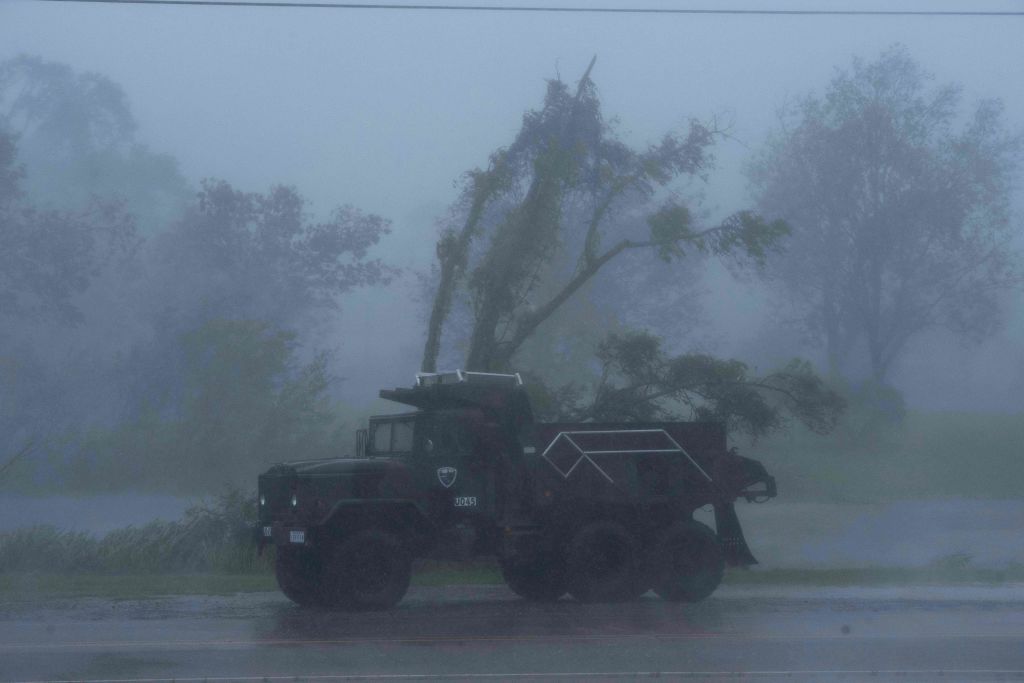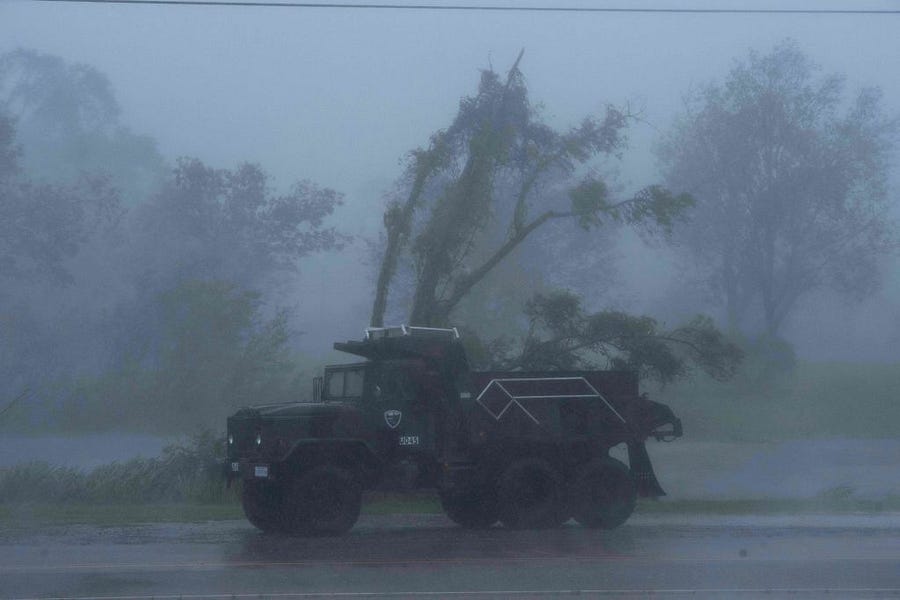Happy Monday! As journalists, we are wont to obsess over the tiniest details, rewriting passages over and over again until we feel they are perfect—or an editor forces us to hit publish.
All that’s to say, thank you to Universal Music Group for allegedly just going ahead and releasing Kanye West’s latest album yesterday without his approval. Somebody needed to intervene and end the months of tinkering.
We wish our “rough drafts” were as good as Kanye’s.
Quick Hits: Today’s Top Stories
-
American forces conducted at least two drone strikes in Afghanistan over the weekend, hitting a pair of ISIS-K planners in Nangarhar province on Friday and on Sunday taking out an explosive-filled vehicle in Kabul believed to be an “imminent” ISIS-K threat to Hamid Karzai International Airport. President Joe Biden had said on Saturday that a terrorist attack was “highly likely in the next 24-36 hours,” leading the U.S. Embassy in Afghanistan to warn Americans to leave the airport immediately.
-
The Pentagon on Saturday confirmed the identities of the 13 U.S. servicemembers killed in Kabul last week. The casualties range in age from 20 to 31. President Biden traveled to Dover, Delaware, yesterday to attend the dignified transfer of the soldiers’ remains and meet with the service members’ families.
-
In an interview with the New York Times, 83-year-old Supreme Court Justice Stephen Breyer acknowledged that he is weighing retirement at some point in the near future. “I don’t think I’m going to stay there till I die,” he said. “Hope not.”
-
The United Nations’ International Atomic Energy Agency reported over the weekend that North Korea appears to have resumed operation of its Yongbyon nuclear reactor, which was believed to be inactive from December 2018 through July 2021.
-
The Office of the Director of National Intelligence released an unclassified summary of the intelligence community’s investigation into the origins of COVID-19 on Friday. Although the various agencies were able to “reach broad agreement” that SARS-CoV-2 “probably” emerged no later than November 2019 and that Chinese officials did not have foreknowledge of the virus before the outbreak, they could not come to firm conclusions on where the outbreak originated. “China’s cooperation most likely would be needed to reach a conclusive assessment of the origins of COVID-19,” the summary concludes. “Beijing, however, continues to hinder the global investigation, resist sharing information and blame other countries.”
-
A state judge ruled on Friday that local school districts in Florida can impose mask requirements on students and teachers, finding that the DeSantis administration’s efforts to punish districts that do so violated the Florida Constitution. A spokesperson for Gov. DeSantis said the state plans to appeal the ruling.
-
Actor Ed Asner—known for his Emmy-winning performance as Lou Grant on “The Mary Tyler Moore Show”—died on Sunday at the age of 91. Legendary reggae singer and producer Lee “Scratch” Perry died on Sunday in Jamaica at the age of 85.
Ida Hits

Louisiana Gov. John Bel Edwards said at a news briefing on Saturday that Hurricane Ida “will be one of the strongest hurricanes to hit anywhere in Louisiana since at least the 1850s.” He was right.
Hurricane Ida was downgraded to a tropical storm over night, but it made landfall in Louisiana as a Category 4 storm twice on Sunday afternoon, first in Port Fourchon and then again a few hours later in Lafourche Parish. Its 150 mph winds tied it with last year’s Hurricane Laura and 1856’s Last Island Hurricane for the strongest hurricane to ever hit Louisiana.
Residents were quick to feel the effects: As of early Monday morning, more than 1 million Louisianans—and 43,000 Mississippians—were without power, and one of the state’s energy providers, Entergy Corp., said in a statement Sunday that customers in the hardest hit areas of the state could be blacked out for a while.
“Based on historical restoration times, customers in the direct path of a Category 4 hurricane can experience outages up to three weeks,” the statement read. “Significant damage, flooding and accessibility challenges due to the storm will affect our ability to reach some areas of our territory right away and could delay restoration in those communities.”
The storm will have plenty of other downstream effects—or upstream effects, as the U.S. Geological Survey found that Ida temporarily reversed the course of the Mississippi River, causing it to flow south to north. According to the Bureau of Safety and Environmental Enforcement, approximately 95 percent of oil and gas production in the Gulf of Mexico has been shut off.
Ida hit Louisiana 16 years to the day after Katrina, but this year’s storm has, thankfully, thus far proven to be far less deadly. Just one death was attributed to the hurricane on Sunday; someone was struck by a falling tree.
A New Orleans infrastructure official told the Associated Press that the city is a “very different place than it was 16 years ago,” and Gov. Edwards projected confidence early on Sunday that the state’s $14 billion levee system would withstand the storm.
“All of our modeling shows that the most populous parts of southeast Louisiana inside that [enhanced hurricane and storm risk reduction system] are going to be protected from storm surge,” Edwards told CBS News’ Face the Nation.
But the levee system doesn’t cover everyone. “We have lesser systems of protection built along the coast where the levees aren’t as hot and they’re not as fortified,” Edwards added. “This would be a tremendous test of those systems. And quite frankly, it’s going to be the strongest test we’ve had yet for the current hurricane and storm risk reduction system itself.”
New Orleans Mayor LaToya Cantrell on Friday ordered mandatory evacuations strictly for those living outside the main levee system, but otherwise told residents to hunker down and prepare to ride out the storm. “We are not calling for a mandatory evacuation because the time simply is not on our side,” she said. “We do not want to have people on the road, and therefore in greater danger.”
Those calls to remain indoors extended to Sunday night. “Please do not venture outside even to try and help people,” the National Weather Service New Orleans tweeted. “Yes we all want to help so badly but you will only put your life in danger as well. Everyone needs to still shelter in place.”
President Biden approved Louisiana and Mississippi’s disaster declarations over the weekend, unlocking federal funding that can go toward temporary housing and home repairs, uninsured property losses, and debris removal.
“As soon as the storm passes, we’re going to put the country’s full might behind the rescue and recovery,” Biden said during a stop at the Federal Emergency Management Agency (FEMA) headquarters yesterday. “And I mean that.”
FEMA announced Sunday it had shipped more than 3.5 million meals, 2.5 million liters of water, and 185 generators to the affected areas, and added that more than 950 search-and-rescue personnel have been deployed to begin operations as needed. Gov. Edwards has activated nearly 5,000 National Guard members as well.
Complicating all of this is Louisiana’s COVID-19 situation. The state is just 41 percent fully vaccinated, and fifth in the country in COVID hospitalizations per capita, though it’s latest surge seems to have crested.
“Evacuating these large hospitals is just not an option because there’s not any other hospitals with the capacity to take them,” Edwards said on CBS. “When you think in terms of hospitals, it’s just not possible. So we know that they have been working extremely hard. They all have generators. They all have the fuel on hand and the extra food and the things that they’re going to need. But quite frankly, the wind, we expect, will cause power outages across much of southeast Louisiana. It’s impossible today to say how long the power will be out. And that begins to test your systems.”
Is It Time for the Fed to Stop Buying Bonds?
Every year, the Federal Reserve Bank of Kansas City hosts an economic policy symposium in Jackson Hole, Wyoming, with the goal of “bring[ing] together economists, financial market participants, academics, U.S. government representatives and news media to discuss long-term policy issues of mutual concern.” It’s a pretty swanky event, as far as economic policy symposia go.
But this year’s summit was virtual, and the reason why was a repeat topic of conversation. “At the [Federal Open Market Committee’s] recent July meeting, I was of the view, as were most participants, that if the economy evolved broadly as anticipated, it could be appropriate to start reducing the pace of asset purchases this year,” Federal Reserve Chair Jerome Powell said in his keynote speech on Friday. “The intervening month has brought more progress in the form of a strong employment report for July, but also the further spread of the Delta variant.”
Brokers on Wall Street—and power brokers in Washington—were focused on Powell’s remarks last week as investors waited to see if he would join the growing chorus of central bankers calling for a tapering of the Federal Reserve’s $120 billion in monthly U.S. Treasury bonds and mortgage-backed securities.
“It is a question of when, not a question of if,” Minneapolis Federal Reserve President Neel Kashkari said earlier this month regarding the Fed’s bond-buying. “There’s a lot of public discussion about, will it be at the end of this year, will it be the beginning of next year: Those seem like reasonable ranges of deliberation, but ultimately it will be driven by the data.”
“I think we want to get going on taper,” St. Louis Federal Reserve President James Bullard added last week. “Get the taper finished by the end of the first quarter next year, and then we can evaluate what the situation is and we’ll be able to see at that point whether inflation has moderated. And if that’s the case we’ll be in great shape. If it hasn’t moderated, we’re going to have to be more aggressive to contain inflation.”
The Fed announced a suite of new tools in March 2020—including these enhanced asset purchases—as a means of stabilizing the pandemic-addled economy and “promot[ing] a swift recovery once the disruptions abate.” Nearly a year and a half later—with higher than expected inflation threatening to overheat financial markets—many say the time for weaning is here.
“The idea behind quantitative easing [another name for the aforementioned asset purchases] is to lower medium- and longer-term interest rates and increase asset prices so that the private sector will spend more,” Larry Summers—treasury secretary under former President Bill Clinton and director of the National Economic Council under former President Barack Obama—wrote in the Washington Post last week. “Why is this still a sensible objective when job openings are at a record high, inflation is running well above the Fed’s target, and housing inflation is not yet reflected in official indices even though the average new tenant is paying 17 percent more than her predecessor?”
Summers concluded with a theory of why Powell has yet to change course. “The Fed is running quantitative easing at current levels not because anyone has analyzed that as appropriate given current conditions,” he argued. “Rather, there is a felt need to maintain credibility given previous commitments and a reluctance to accept the immediate pain and dislocation associated with changing course, coupled with faith in the ability to manage the situation down the road.”
Powell tried to split the baby on Friday, signaling that he and the Federal Reserve are aware—and on top—of inflationary pressures without gesticulating too wildly about the upcoming taper in such a manner that would spook the markets. As an added bonus, the speech served more or less as a job interview: Powell’s term is up in early 2022, and Biden is currently in the process of deciding whether to renominate the Trump administration holdover. (Powell’s renomination has received a remarkably bipartisan backing from GOP Sen. Steve Daines, progressive economist Dean Baker, and, reportedly, Treasury Secretary Janet Yellen.)
“The rapid reopening of the economy has brought a sharp run-up in inflation: Over the 12 months through July, measures of headline and core personal consumption expenditures inflation have run at 4.2 percent and 3.6 percent, respectively—well above our 2 percent longer-run objective,” Powell noted before taking a dovish turn. “But that concern is tempered by a number of factors that suggest that these elevated readings are likely to prove temporary.”
Powell, toward the end of his remarks, concluded that it “could be appropriate” to begin the tapering process this year, but opted against providing a firm timeline. “We have said that we would continue our asset purchases at the current pace until we see substantial further progress toward our maximum employment and price stability goals,” he said. “My view is that the ‘substantial further progress’ test has been met for inflation. There has also been clear progress toward maximum employment. … We will be carefully assessing incoming data and the evolving risks.” The Fed’s next chance will come on Friday morning, when the Labor Department is set to release the August jobs report. Another number like July’s 943,000 could certainly accelerate Powell’s timeline.
Harry Truman would have been frustrated by the Fed chair’s equivocations on Friday, but President Biden likely wasn’t: The S&P 500 and Nasdaq both hit record highs following Powell’s remarks.
Worth Your Time
-
A group of Washington Post reporters put together a remembrance of the 13 U.S. servicemembers who lost their lives in last Thursday’s terrorist attack. The mother of 20-year-old David Espinoza from Rio Bravo, Texas, now has a “David-sized hole” in her heart that “nobody can fill.” Nicole Gee of Roseville, California, had just texted her dad from Afghanistan a few days before her death. “She said she was having the experience of her life,” her father said. “And I told her I was proud of her.” Wyoming’s Rylee McCollum, 20, had just gotten married in February and was expecting his first child. “Roice McCollum said that her family and McCollum’s wife, Jiennah, who lives in San Diego, are devastated, but that ‘we knew he was where he wanted to be: serving his country.’”
-
For ABC News, James Gordon Meek tells the harrowing story of a volunteer group of American veterans of the Afghanistan war who conducted a clandestine mission—dubbed “Pineapple Express”—to get hundreds of at-risk Afghans to safety. “With the uniformed U.S. military unable to venture outside the airport’s perimeter to collect Americans and Afghans who’ve sought U.S. protection for their past joint service, they instead provided overwatch and awaited coordinated movements by an informal Pineapple Express ground team that included ‘conductors’ led by former Green Beret Capt. Zac Lois, known as the underground railroad’s ‘engineer,’” Meek writes.
-
“The massacre at Hamid Karzai airport was the consequence of President Biden’s decision to rely on the Taliban for security,” Matthew Continetti argues in a column for the Washington Free Beacon. “Despite the lunacy of taking the Taliban at its word, the Biden administration sounded in recent days as if Haqqani, Mujahid, and the rest of their deranged crew were U.S. partners. Not only did Biden’s botched withdrawal result in America’s departure from Central Asia, Taliban rule in Afghanistan, a catastrophe for democracy and human rights, and a propaganda boon for the global jihadist-Salafist movement.”
Presented Without Comment
Toeing the Company Line
-
We’ve heard a lot about ISIS-K in recent days. In Friday’s Vital Interests (🔒), Tom Joscelyn explains what the group is and what we know about how they operate. “Al-Muhajir’s men are prolific terrorists,” he writes. The U.N. Assistance Mission in Afghanistan documented 77 attacks that were either claimed by ISIS-K or attributed to it in the first four months of 2021 alone. Some of these were carried out in Kabul, where al-Muhajir’s network has regularly targeted civilians, as well as the now deposed Afghan government.”
-
In his Sunday French Press, David argues that it’s time to stop rationalizing and enabling Evangelical vaccine rejection. “America is chipping away at vaccine reluctance,” he writes. “[But] the remaining vaccine holdouts are growing more extreme, and significant parts of the Christian Right are enabling, excusing, and validating Evangelical behavior that is gravely wrong and dangerous to the lives and health of their fellow citizens.”
-
Rep. Mike Gallagher of Wisconsin dropped by Friday’s Dispatch Podcast with Steve and Sarah to discuss the Biden administration’s withdrawal from Afghanistan. The Marine Corps veteran explains what he’d like to see from the White House going forward and the national security platform he’d push for the GOP to adopt.
-
On the site over the weekend, Alec reviewed Marvel’s new multiverse-centric TV show, What If. “Disney has long been the leading purveyor of nostalgia in film, churning out remake after sequel after reboot with no end in sight,” he writes. “…But what if instead of relying on old properties, Disney produced original content? That’s a ‘what if’ worth exploring.”
-
Chris Stirewalt asks an important question in a piece on the site today: Who, if anyone, would have handled the Afghan withdrawal better than Biden? It’s a tough question with no reassuring answer
-
Khuzestan province is home to 80 percent of Iran’s oil fields and 60 percent of its natural gas reserves, yet its residents are poverty stricken and thirsty. On the site day, Charlotte looks at what was behind protests that broke out in the region in July and finds that it’s more than water shortages.
Let Us Know
What’s the most extreme weather event you’ve ever lived through?
Reporting by Declan Garvey (@declanpgarvey), Andrew Egger (@EggerDC), Charlotte Lawson (@charlotteUVA), Ryan Brown (@RyanP_Brown), Harvest Prude (@HarvestPrude), and Steve Hayes (@stephenfhayes).







Please note that we at The Dispatch hold ourselves, our work, and our commenters to a higher standard than other places on the internet. We welcome comments that foster genuine debate or discussion—including comments critical of us or our work—but responses that include ad hominem attacks on fellow Dispatch members or are intended to stoke fear and anger may be moderated.